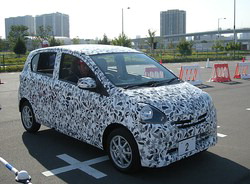New Daihatsu e:S Gets 30 KM per Liter (70.6 MPG) for 800,000 Yen
Daihatsu showed off its new 3-cylinder engine technology to Japanese journalists on July 19th. The result is that this e:S (pronounced “ees”) kei car achieves 30 KM per liter (70.6MPG) under the new (April 2011) Japanese government standards. Under the previous measurement standards, this would have been an even more impressive 32 KM per liter (75.3 MPG), which is quite an incredible feat for a non-hybrid car.
Toru Ueda, the Executive Chief Engineer of Daihatsu’s Technology Division hailed this frugal performance:
“We were aiming to create a car that was cheap with good gas mileage. I would like to put it to you that this car should be seen as a third type of “eco” car, along with electric and hybrid vehicles”
The 3-cylinder engine itself brought about a fuel efficiency improvement of 14.2%. Then on top of this engineers were able to pare 60KG without compromising on strength. Now that’s a lot of weight saved on a car that did not weigh that much in the first place. The final piece of the fuel-saving jigsaw was a new start-stop system that can shut off the engine at speeds under 7 KM/H.
So it is definitely fuel-efficient. To put the economy figures into perspective, the Prius achieves 35.5 KM per liter under the pre- April 2011 standards, a figure that the e:S is only just shy of, despite being a regular ICE car.
How about Ueda’s other goal, pricing? Well, the story is that when this new e:S goes on sale in September 2011, the base model will retail for just 800,000 Yen (around $10,000 USD with the current appalling exchange rate) before taxes. How does that compare with the Prius? Well, the base model Prius is 2.05 million Yen – a price you will be able to buy two and a half Daihatsu e:S kei cars for. Cheap and frugal. What better for Japanese city dwellers in these lean economic times?
Mission accomplished, then. I think Ueda san can give his team a pat on that back, or at least a decent summer bonus.
Source: Mainichi Shinbun (Japanese-language)



